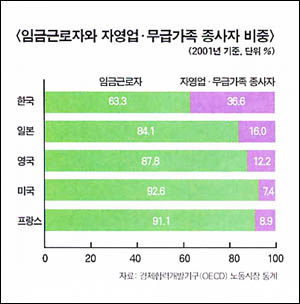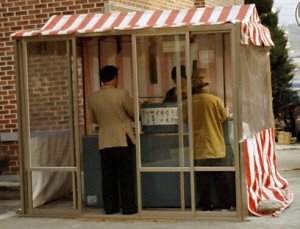Unemployment in Korea
| Hankyoreh21 pays attention to the constantly low unemployment rate despite of the poor economy. By "normal logic", more and more should be seeking work due to dimished income of the main breadwinner, but the official unemployment rate stays at 3+ percent. According to the ROK statistical standards, those who work at least 1 hour (!) a week are counted as employed. And those who are not listed as job seekers are put into the category of economically inactive (비경제활동인구). That population has grown from 13.9 million in 1998 to 14.6 million in August 2004. [In general, 3/4 of the male and 1/2 of the female adult population in Korea is economically active.]  The following are the reasons why the formal unemployment rate stays so low, while the actual rate is estimated to be twice the official figure, over 7%. The following are the reasons why the formal unemployment rate stays so low, while the actual rate is estimated to be twice the official figure, over 7%. • The relatively large portion of agricultural population, close to 9%; absorbs population which otherwise would be unemployed • The large proportion of self-employed in the occupational structure, the non-paid family workers included (for example when a couple keeps a restaurant, it's usually the woman working with her husband who's counted as a "non-paid family worker" (mugûp kajok chongsaja). The article gives the figure 35%; this has been quite contant throughout the modern Korean history within the urban employment. The article notes further that while many removed from wage labor become active in unstable self-employment, these people rarely become formally unemployed despite of the state of the small business however low and poor the quality of that kind of employment is.  • The statistics have been constructed so that it mainly reflects permanent employment, even though employment structure has been changing towards non-permanent (pijônggyujik), unstable employment. • The number of those working for more than 54 hours a week has increased by 17% from last year; low-wage non-permanent workers do long hours to earn sufficiently for living, and the work load of the permanently employed has grown since companies have not been hiring. Picture to the right: a pungôppang (bungeobbang, fish-shaped pastry) grill in Sillim-dong in 1999; typical of the kind of petty self-employment, into which unemployment is absorbed. (C) AL 1999 Categories at del.icio.us/hunjang: work ∙ stratification ∙ employment ∙ self-employment |



Comments to note "Unemployment in Korea" (Comments to posts older than 14 days are moderated)
Write a Comment